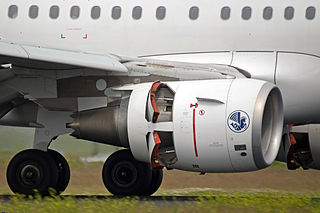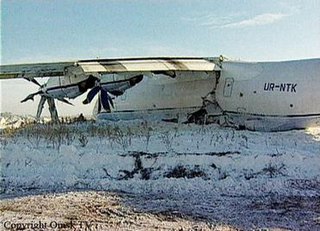
Thrust reversal, also called reverse thrust, is the temporary diversion of an aircraft engine's thrust for it to act against the forward travel of the aircraft, providing deceleration. Thrust reverser systems are featured on many jet aircraft to help slow down just after touch-down, reducing wear on the brakes and enabling shorter landing distances. Such devices affect the aircraft significantly and are considered important for safe operations by airlines. There have been accidents involving thrust reversal systems, including fatal ones.

The Antonov An-10 Ukraina is a four-engined turboprop passenger transport aircraft designed in the Soviet Union.

The Antonov An-26 is a twin-engined turboprop civilian and military transport aircraft, designed and produced in the Soviet Union from 1969 to 1986. It is the third member of the Antonov An-24 family, coming after the An-24 and An-30, while preceeding the An-32 and canceled An-132.
Silk Way Airlines is an Azerbaijani private cargo airline with its head office and flight operations at Heydar Aliyev International Airport in Baku. It operates freight services to Asia, the Middle East and Europe, as well as services for government and non-governmental organisations. The airline is part of the Silk Way Group.

S7 Airlines Flight 778(S7778/SBI778) was a scheduled domestic passenger flight from Moscow to Irkutsk, Russia. On 9 July 2006, at 06:44 local time, the Airbus A310-324 aircraft operating the route overran the runway during its landing in Irkutsk. The aircraft failed to stop and crashed through the airport's concrete perimeter fence, struck rows of private garages and burst into flames, killing 125 people.

Mohawk Airlines Flight 405, a Fairchild Hiller FH-227 twin-engine turboprop airliner registered N7818M, was a domestic scheduled passenger flight operated by Mohawk Airlines that crashed into a house within the city limits of Albany, New York, on March 3, 1972, on final approach to Albany County Airport, New York, killing 17 people. The intended destination airport lies in the suburban Town of Colonie, about 4 miles north of the crash site.

Spanair Flight 5022 or (JK5022/JKK5022) was a scheduled domestic passenger flight from Barcelona–El Prat Airport to Gran Canaria Airport, Spain, with a stopover in Madrid–Barajas Airport that crashed just after take-off from runway 36L at Madrid-Barajas Airport to Gran Canaria Airport at 14:24 CEST (12:24 UTC) on 20 August 2008. The aircraft was a McDonnell Douglas MD-82, registration EC-HFP. Of the 172 passengers and crew on board, 154 died and 18 survived.
Aviaarktika was a Soviet airline which started operations on 1 September 1930 and was absorbed by Aeroflot on 3 January 1960.

On April 4, 1955, a United Air Lines Douglas DC-6 named Mainliner Idaho crashed shortly after taking off from Long Island MacArthur Airport, in Ronkonkoma, Islip, New York, United States.

On 5 November 2010, JS Air Flight 201, a Beechcraft 1900 passenger aircraft on a charter service from Karachi to the Bhit Shah gas field in Sindh, Pakistan, crashed near Karachi's Jinnah International Airport, after suffering an engine malfunction at take-off. All 21 people on board were killed.

Sita Air Flight 601 (ST601/STA601) was a Nepalese domestic passenger flight, operated by Sita Air from Tribhuvan International Airport in Nepal's capital Kathmandu to Tenzing-Hillary Airport in Lukla. On 28 September 2012, the Dornier 228 serving the route crashed while attempting an emergency landing at Kathmandu shortly after takeoff, killing all 19 people on board.
The minimum control speed (VMC) of a multi-engine aircraft is a V-speed that specifies the calibrated airspeed below which directional or lateral control of the aircraft can no longer be maintained, after the failure of one or more engines. The VMC only applies if at least one engine is still operative, and will depend on the stage of flight. Indeed, multiple VMCs have to be calculated for landing, air travel, and ground travel, and there are more still for aircraft with four or more engines. These are all included in the aircraft flight manual of all multi-engine aircraft. When design engineers are sizing an airplane's vertical tail and flight control surfaces, they have to take into account the effect this will have on the airplane's minimum control speeds.

Sepahan Airlines Flight 5915 was a scheduled domestic passenger flight from Iranian capital Tehran Mehrabad International Airport to Tabas, South Khorasan province, Iran. On 10 August 2014, the HESA IrAn-140 twin turboprop serving the flight crashed shortly after takeoff from Mehrabad International Airport, falling into a boulevard near the Azadi Stadium. Of the 42 passengers and six crew on board, 40 people died.

On 27 January 2001, an Antonov An-70 prototype crashed close to Omsk Tsentralny Airport, Russia during testing of the aircraft. All 33 passengers and crew on board the aircraft survived.

The Antonov An-12 is a transport aircraft designed and manufactured by the Ukrainian manufacturing and services company Antonov. Given the long operational history of the An-12, more than 190 An-12s have crashed involving many casualties. The An-12 has also been involved in a number of aviation incidents.

On 4 July 1966, an Air New Zealand Douglas DC-8-52 crashed on takeoff from Auckland International Airport on a training flight, killing 2 out of the 5 crew members on board. The crash was the first fatal accident in the history of Air New Zealand and the only accident to date of a commercial airliner in New Zealand. The investigation concluded that during the captain's attempt to simulate an engine failure, the captain accidentally deployed the thrust reverser on the number four engine. This resulted in the aircraft's speed falling below the minimum control speed, which resulted in the aircraft becoming uncontrollable and the eventual crash.

Aeroflot Flight A-13 was a scheduled Soviet domestic passenger flight from Baku, Azerbaijan to Fort-Shevchenko in Kazakhstan that crashed on 18 August 1973 shortly after takeoff killing 56 of the 64 passengers and crew aboard. The Antonov An-24 had suffered an engine failure on takeoff and was attempting to return to the airport when it struck an oil rig cable at low altitude resulting in a crash. At the time, it was the second deadliest accident involving the An-24 and remains the second deadliest aviation accident in Azerbaijani history. The engine failure had been caused by the effect of continuous overheating on the performance of the blades.

Aeroflot Flight L-51 was a scheduled domestic passenger flight operated by an Antonov An-24 that crashed on approach to Liepāja International Airport on 30 December 1967, resulting in the death of 43 of the 51 people on board. To date, it is the deadliest aviation accident in Latvian history. The investigation revealed the cause of the accident to be pilot error.

Angara Airlines Flight 200 was a domestic scheduled flight from Ulan-Ude Airport to Nizhneangarsk Airport, Russia. On 27 June 2019, the Antonov An-24RV aircraft operating the flight suffered an engine failure on take-off. On landing at Nizhneangarsk, the aircraft departed the runway and collided with a building. The captain and flight engineer were killed. Many of the 43 passengers sustained injuries.

Kalitta Air Flight 207 (K4207/CKS207) was a scheduled cargo flight between John F. Kennedy Airport to Bahrain International Airport with a technical stopover at Brussels. On May 25, 2008, the Boeing 747-200 suffered a bird strike and overran runway 20 during takeoff at Brussels Airport, causing the aircraft to split into three large pieces. The occupants sustained minor injuries.

















